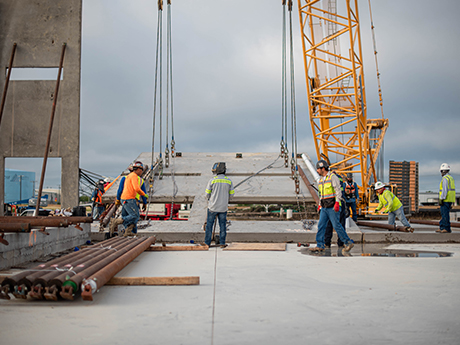By Ray Catlin, Texas regional vice president at LGE Design Build
The construction industry is at a critical crossroads, facing an unprecedented labor shortage that threatens to disrupt project timelines, increase costs and impact overall quality.
Over the course of 2025, the sector is projected to require an additional 454,000 workers — a gap that continues to widen as seasoned professionals retire faster than new talent enters the field. This labor shortage was first felt during the 2008–2009 financial crisis when the market downturn prompted many experienced workers to retire early or exit the industry entirely. While the industry saw periods of recovery in the years that followed, the COVID-19 pandemic reignited and exacerbated workforce disruptions, accelerating early retirements and prompting many to pursue careers in other sectors.
Without proactive solutions, this workforce shortfall could jeopardize the industry’s ability to meet growing demand. Addressing the challenge requires a comprehensive strategy that embraces collaboration, innovation and workforce development.

Consequences of a Growing Skills Gap
The current labor shortage is driven by a shrinking pipeline of skilled workers. With only 9 percent of the workforce under the age of 25, the industry is struggling to attract younger generations into the trades.
The result? Extended project timelines, rising labor costs and increased safety concerns. When job sites operate with fewer experienced workers, the risk of compliance issues and workplace incidents rises — a challenge that further underscores the urgency of investing in skilled labor.
Aging infrastructure, new development demand due to population growth and economic fluctuations further exacerbate the situation, making workforce efficiency a top priority for construction firms. To navigate these challenges, industry leaders must adopt forward-thinking solutions that streamline operations and optimize existing resources.
Solution: Integrated Project Delivery
One of the most effective ways to mitigate labor shortages is through alternative project delivery methods, including design-build. This approach emphasizes early collaboration between owners, designers and contractors, leading to better alignment of workforce availability and project scope.
The design-build process, which prioritizes engaging subcontractors from the outset, eliminates inefficiencies that are common in traditional design-bid-build models. Instead of awarding contracts solely based on cost, this method focuses on expertise and capacity, ensuring teams are adequately staffed to meet project demands. This proactive approach reduces delays, enhances quality control and fosters a more predictable workforce environment.
Technology’s Role in Workforce Optimization
Incorporating technology is another key strategy for counteracting labor shortages. From automation to artificial intelligence, cutting-edge tools are reshaping construction processes, enabling companies to do more with fewer workers.
Key advancements include:
- AI-powered scheduling tools that analyze real-time data to optimize labor allocation and prevent bottlenecks.
- Robotic layout systems that streamline framing and foundation work, reducing the need for additional manpower while improving accuracy.
- Automated painting and finishing systems that require minimal oversight, increasing efficiency without compromising quality.
Beyond field applications, digital project management platforms are enhancing coordination across teams. Cloud-based collaboration tools simplify document sharing, scheduling and resource tracking, thus ensuring seamless communication among stakeholders.
Embracing technology not only improves efficiency but also makes the industry more attractive to younger workers who are drawn to tech-driven careers. By modernizing job sites and workflows, construction firms can position themselves as innovative employers that offer long-term career growth in a rapidly changing industry.
Creating a Sustainable Model
Retaining skilled labor is just as critical as attracting new talent. Improving jobsite conditions, fostering positive work cultures and addressing financial challenges can significantly impact workforce stability in the following ways:
- Enhancing jobsite environments: Providing shaded rest areas, onsite meals and climate-controlled break spaces demonstrates a commitment to worker well-being.
- Recognizing skilled laborers: Celebrating tradespeople at groundbreaking ceremonies, project milestones and industry events elevates their role in the sector’s success.
- Streamlining payment processes: Lengthy compensation cycles create financial strain, especially for smaller subcontractors. Implementing faster and more transparent payment structures can help sustain the workforce and encourage growth.
Reframing the Industry’s Image
Long-term workforce development hinges on changing the industry’s narrative. Many young professionals overlook construction as a viable career path due to outdated perceptions. Grassroots efforts — such as partnerships with high schools, trade schools and universities — can help shift this mindset by showcasing construction as a lucrative, technology-driven field with diverse opportunities.
The expansion of high school construction programs, many of which offer students industry certifications and hands-on experience before graduation, equips them with a deeper understanding of the diverse career opportunities and long-term growth potential within the construction industry.
By actively engaging with students through apprenticeship programs, internships and mentorship initiatives, the industry can build a stronger talent pipeline. Highlighting success stories of young professionals who have thrived in construction can further reinforce the sector’s appeal.
A Path Forward
The construction industry’s ability to meet future demand depends on its willingness to evolve. By embracing collaboration, leveraging technology and fostering workforce development, companies can create a more resilient and efficient industry.
The road ahead requires innovation and strategic investment, but with the right approach, construction firms can not only address labor shortages but also lay the foundation for long-term success.
Ray Catlin is the Texas regional vice president at LGE Design Build, a design-build firm that has been active in the commercial market for 30 years.


